We're still micromanaging in 2025. Leaders spend their days directing every move, convinced that without constant input, everything falls apart. Meanwhile, the best-performing organizations are doing the opposite - they're letting go.
Here's the paradox: the path to greater control lies through releasing it. This isn't management theory - it's how evolution built life's complexity without a blueprint, how markets coordinate millions of transactions without a central planner, how your body runs thousands of processes right now with zero conscious oversight from you.
Traditional leadership treats organizations like machines, but companies are complex adaptive systems that evolve, not engines that obey.
The shift is simple but uncomfortable: stop trying to make every decision yourself. Start architecting the conditions where better decisions emerge everywhere. You still own vision, resources, and boundaries - you just stop playing every position at once.
What you gain is far more powerful than the illusion of control. You gain systems that adapt faster than you could alone, learn while competitors seek approval, and unlock capabilities you didn't know existed. In a world changing by the week, clinging to control guarantees you'll lose it.
By the end of this, you'll see why letting go - done right, with proper safeguards - is the only durable way to win.
Leaders cling to control because it feels predictable. You know what's happening, you make the calls, and the illusion of certainty is comforting. But predictability in a changing environment is just slower failure.
Think about what you actually lose when you try to control everything.
Speed dies. Every decision bottlenecks at your desk. Your team can solve a problem in an hour, but they're waiting three days for your approval while the competitor who pushed that decision down already shipped. The delay compounds - one blocked decision creates three more, and suddenly your entire organization is moving at the pace of your calendar availability.
Intelligence dies. Your people on the ground see things you'll never catch from the executive floor - the customer complaint signaling a bigger problem, the workflow grinding to a halt, the competitor move that just landed. They know, you don't, but you're making the decision anyway. Worse, after a few rounds of having their insights ignored or overridden, they stop surfacing them entirely.
Adaptation dies. When people can't act without permission, they stop trying to improve things. They wait to be told. The system calcifies into a rigid structure that can only move when you push it, and you can't push everywhere at once.
Here's what the data shows: engagement is cratering, especially among managers. Gallup's 2024 numbers are brutal - roughly one in five employees is actually engaged. Control cultures don't just slow you down, they burn people out and send your best talent to competitors who trust them.
Picture this: your best engineer sees a critical architecture flaw that'll cause problems in six months. She could fix it in a week. But it's not in the roadmap you approved, so she emails you, waits for the meeting, explains the technical details you half-understand, and waits for your decision.
Three weeks later you say yes. By then she's demoralized, the window for an easy fix has closed, and she's started talking to recruiters.
And here's what leaders miss - it's not that their people can't be trusted. When you set up the right rewards and give fast feedback, people learn and get better results over time. Short-term uncertainty beats long-term irrelevance.
The real cost of control? It prevents evolution.
The outside environment changes by the week. Customer preferences shift, competitors pivot, technology advances, market conditions flip. If your system can't adapt without you directing every move, it's already obsolete. You're just waiting for the inevitable.

So if control fails in changing environments, what works instead?
Look at any busy marketplace - a farmers market, stock exchange, even Amazon's seller platform. Thousands of sellers, millions of buyers, all making independent decisions. No central authority sets every price or directs every transaction.
Yet prices find their level. Supply meets demand. Good products rise, poor ones disappear. The whole system coordinates itself through millions of small decisions. Each person follows their own interests, but the collective result serves everyone better than any central planner could design.
No one's in control. Yet it works.
That's emergence - complex order arising from simple rules and local adaptation. Evolution didn't design the human eye or the bird's wing through central planning. It unleashed billions of small experiments, kept what worked, ditched what didn't.
The result? Sophistication no individual person could have conceived, let alone drawn up.
Ant colonies build complex architecture through simple pheromone trails. Birds fly in massive flocks, all turning together at once. No one's giving orders.. Slime molds, despite having no brain, solve maze problems by finding optimal paths through pure trial and error.
Simple rules. Local information. Emergent genius.
Markets work the same way, and they've been proving it for centuries. Adam Smith's "invisible hand" isn't philosophy - it's a coordination mechanism that actually works. Millions of people pursuing their own interests, operating inside clear rules, somehow producing outcomes that benefit everyone.
Market prices aggregate information better than any central planner ever could. When toilet paper runs short, prices signal scarcity instantly. Producers respond, supply adjusts, shelves restock. No bureaucrat required, no committee meetings, no approval chains.
Friedrich Hayek extended this insight in ways most leaders still don't grasp. Markets function as distributed information-processing systems. Each participant has local knowledge - what customers actually want, what's feasible to build given real constraints, what competitors are doing this week.
The price system aggregates all of it in real time, processing information scattered across millions of minds. Central planning can't compete because no single authority, no matter how smart, can match that processing power.
Modern platforms prove it scales even further. Amazon doesn't control every seller's inventory decisions - there are millions of them. Google doesn't dictate what content creators publish. Facebook doesn't choreograph billions of daily interactions.
They architect conditions - algorithms, policies, incentive structures - then let complexity emerge from the edges.
Here's the insight that changes everything: this pattern repeats at every scale. The economy operates largely through decentralized control and continues to grow.
But at the individual company level, certain centralized controls become important - strategy, capital allocation, risk boundaries.
Leaders can have cascading decentralized control on execution across teams while centralizing financial and strategic requirements.
Scale down further. Your own body runs on this exact principle. You decentralize the function of internal organs - heart, lungs, liver, kidneys all self-regulating - while maintaining executive control over eating, sleeping, and meeting basic survival needs.
You don't consciously direct your immune system or tell your liver how to process toxins. You set conditions, the system handles execution.
It's fractal. The same principle works whether you're coordinating a $20 trillion economy or a team of eight people.
Centralize intent and resources. Decentralize execution and learning.
That's the pattern. And it's been working for millions of years.

So what does a leader actually do if they're not directing every action?
You shift from commanding moves to designing the field. Your role becomes: set the game, define the boundaries, align the incentives, then get out of the way.
It's a fundamentally different job, and most leaders struggle with the identity shift because it requires letting go of what made them feel important.
Look at Haier. They pushed P&L responsibility down to micro-enterprises - small units with direct user connection. Each one operates almost like an independent company with its own budget and customer relationships.
The result? Faster innovation because decisions don't bottleneck at headquarters. Better accountability because there's nowhere to hide when you own the numbers. People act like owners because, effectively, they are.
Or take Morning Star, the world's largest tomato processor. Zero traditional managers. Coordination happens through colleague commitments - written agreements between peers about what they'll deliver to each other - and transparent metrics everyone can see.
Productivity is higher than competitors. Quality is better. Costs are lower. Turnover is significantly lower.
Why does it work? As founder Chris Rufer puts it: "When people are self-managing, they're more engaged, more accountable, and ultimately more effective."
Both companies prove the same thing: you don't need to control actions to control outcomes.
Coach and system designer. You have the responsibility not of controlling all the parts, but of controlling the incentive structure, the reinforcement mechanisms, and the big-picture strategic resource allocation.
You also have the role of helping others be successful without strict guidelines on their activities.
That's the job. Design the system, coach the people, let the outcomes emerge.
You're still visible - but in results and in how the system behaves, not in how many decisions you personally made this week.

Distributed systems can drift into chaos or exploitation without two critical safeguards.
You can't just tell people "figure it out" and walk away. That's not empowerment - it's abandonment. Real autonomy requires structure, and most leaders who try to "let go" fail because they skip this part.
Individual success must contribute to collective success. Not in theory - in practice, with real consequences.
This means tying rewards to team outcomes, not just individual output. Recognition flows from genuine impact, not politics. Advancement values multiplier effects - did you make others better?
What misalignment looks like:
Misaligned incentives don't just create inefficiency. They create toxicity.
Even with aligned incentives, you need enforcement. Not bureaucratic oversight - decentralized accountability.
Peer monitoring works better than hierarchical control. When team members see each other's contributions and poor performance affects everyone, natural accountability emerges.
But you still need mechanisms to catch exploitation - systems that flag reciprocal rating loops, graduated sanctions for gaming, clear conflict resolution processes.
Elinor Ostrom's research on common-pool resources proved this. Successful self-governing systems share features: clear boundaries, local rule-making, monitoring by peers, graduated sanctions. It's not anarchy - it's structured autonomy with teeth.

Incentives of each agent must be aligned with the outcomes of the whole, and there must be enforcement mechanisms to ensure no foul play and expropriation.
Get both pieces right and distributed systems thrive. Miss either one and the whole thing falls apart.
Theory is easy. Implementation is where leaders freeze up.
Here's the step-by-step path from control to architecture, with specific actions you can take this week.
Write objectives that describe outcomes, not methods. Make them testable - everyone should know if you succeeded or failed.
Bad: "Improve customer satisfaction."
Good: "Reduce support ticket resolution time to under 4 hours with 90% first-contact resolution by Q3."
Share the "why" behind strategic choices. Context enables better decisions. People closer to the problem will find better solutions than you would - but only if they understand what you're trying to achieve.
Tool: OKRs done right. Few objectives (3-5 max), clear key results, public across the organization, time-boxed. Research from BCG shows properly implemented OKRs improve focus and alignment - but most companies botch it by making them too numerous or vague.
Identify recurring decisions that can move to the edge. Start with low-stakes choices to build confidence.
Which customer requests can support approval without escalation? Which budget items can team leads authorize? Which experiments can engineers run without permission?
Create lightweight criteria and clear escalation paths. Leadership expert L. David Marquet suggests a simple test for delegation: ask yourself if you’d be willing to be vulnerable to the effects of your team’s decision. If yes, delegate it.
Celebrate intelligent experiments that fail. Make learning visible through retrospectives. Remove blame from the conversation.
Google's Project Aristotle research found psychological safety is the #1 factor in high-performing teams. Not talent density, not resources - safety to take risks and learn from errors. Without this, people won't use the autonomy you're giving them.
Distributed systems need rich information flows. Share strategic context, customer feedback, performance metrics that were traditionally management-only.
Open dashboards for progress, spend, quality. Let people see how their work impacts the whole. Information asymmetry kills distributed coordination - Hayek proved this decades ago. If someone needs information to make good decisions, they should have it.
Tie bonuses to collective goals, not just individual metrics. Recognition flows from contribution to others' success. This is where most companies fail - they talk teamwork but reward individual heroics.
Make the connection explicit: your success depends on making others successful.

Short-term, letting go creates uncertainty. Long-term, it creates adaptability that compounds. Perhaps this can be true in the short term, but with correctly aligned incentives, the learning mechanism and feedback cycle of people taking initiative will highly likely yield much better long-term outcomes.
Control gives you predictability today. Letting go gives you performance tomorrow. Most leaders aren't willing to make that trade - that's why their organizations stagnate.
Don't flip everything overnight. Start with one team, one set of decisions. Build proof points. Expand as trust and competence grow.
This isn't a light switch - it's a dimmer.
You can screw this up. Some people do. Here are the traps and how to spot them before they kill your momentum.
You say "figure it out" without clear objectives. That's not autonomy - it's abdication.
People spin their wheels. They guess at what you want. They waste weeks building the wrong thing, then get blamed for not reading your mind.
Fix: Crystal-clear outcomes. Flexible methods. Define success well enough that failure is obvious to everyone.
You delegate decisions but don't provide the data people need to make good ones.
They're flying blind. Autonomy without information is just chaos with extra steps. People make confident decisions based on incomplete pictures, then you're frustrated when things go sideways.
Fix: Real-time metrics. Weekly learning loops. Transparent dashboards. Fast feedback is the unlock - without it, distributed systems collapse into expensive guesswork.
Something goes wrong. Your instinct? Grab back all the decisions.
One failure triggers the micromanagement reflex. You just taught everyone that autonomy was temporary, performance theater to keep you happy. Next time they'll wait for permission even when they shouldn't.
Fix: Treat errors as information. Adjust constraints, not autonomy. Ask "what guardrail would have prevented this?" not "who should I have been watching more closely?"
People optimize for what you're measuring. If the metrics are wrong, local wins destroy global value.
Sales chasing volume regardless of profitability. Support closing tickets regardless of resolution. Engineers shipping features regardless of stability. Everyone hits their numbers while the company burns.
Fix: Rewards tied to system success. Add peer oversight. Make the connection between individual behavior and collective outcomes impossible to miss.
Control doesn't just slow you down in a changing environment - it guarantees obsolescence.
The outside environment is always changing, and is changing at an accelerating pace. If a team or a leader can't adapt, their attempt at control will self-defeat, and soon they'll control nothing.
That's the real failure mode. Not the tactical mistakes - the strategic one. Clinging to control in a shifting landscape doesn't preserve what you have. It ensures you'll lose it.

Real control comes from creating systems where desired outcomes emerge naturally.
You still own vision. You still allocate resources. You still set boundaries and enforce fairness. You just stop trying to direct every move, and that shift unlocks something far more powerful than compliance - it unlocks genuine capability.
The pace of change makes control-based leadership obsolete. By the time you make the decision, communicate it down the chain, and wait for execution, the context has shifted. Your carefully crafted plan is addressing yesterday's problem.
Organizations that master distributed leadership don't just move incrementally faster. They're playing a different game. They learn while you're still planning. They adapt while you're still approving. That's not a small advantage - it's existential.
Your job isn't to have all the answers. It's to create conditions where great answers emerge everywhere.
That requires a different kind of confidence. Not "I know what to do" but "I've built a system that figures out what to do faster than I ever could alone." It's uncomfortable - you lose the illusion of control. What you gain is actual influence.
Systems that adapt, learn, and exceed what any single leader could achieve through command alone.
Nature has been running this experiment for billions of years. Markets have been proving it for centuries. Companies like Haier and Morning Star are demonstrating it right now with better results than their control-obsessed competitors.
The pattern is clear. Complex systems thrive when local agents can sense, decide, and act inside smart constraints. Your organization is a complex system.
Pick one decision you make regularly. Something your team could handle with clear criteria. Delegate it this week. Watch what happens.
That's your proof of concept. That's how you learn whether you're ready to let go.
Because in a world that changes by the week, control is a brittle comfort. Letting go is the only durable way to win.